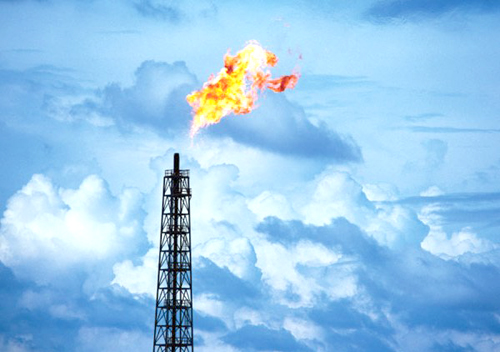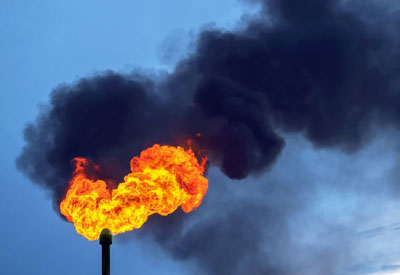| University of Colorado at Boulder | |||||
 |
|||||
|
Impacts of oil and gas development on air quality is a growing issue across the Intermountain West. Of particular concern are flaring, venting, and the effects of fugitive emissions on global climate change. Below you can find out more about these issues as well as how to reduce their impacts on air quality. Center for Western Priorities article on Oil and Gas Drilling Linked to Air Pollution. Flaring and Venting
Gas is vented from oil and gas production equipment for several reasons. Excessive pressure in gas storage tanks and other equipment results in unplanned venting through pressure relief valves. However, the majority of vented gas has nothing to do with pressuring relief. When crude oil is extracted and produced, raw natural gas associated with the oil is also produced to the surface. In areas lacking pipelines and other gas transportation infrastructure, a vast amount of gas is commonly flared as waste. Vented gas is commonly required by law to be routed to a combustion flare. Flaring greatly reduces the emission of volatile organic chemicals (VOCs) and hazardous air pollutants (HAPs) into the air, although a significant amount of the greenhouse gas carbon dioxide is a byproduct of the process. Improperly operating flares can still allow VOCs such as methane and sulfur dioxide and HAPs like aromatic hydrocarbons and benzapyrene into the atmosphere. Additionally, flares are known to kill large numbers of migrating birds and moths. Efforts to identify technologies and policies that will help reduce flaring and capture the economic benefit of currently flared gas include a set of workshops held in several states in 2019. The resulting white paper provides recommendations to address Flaring Issues, Solutions and Technologies. finalized in November 2016 to reduce waste of natural gas from flaring, venting and leaks on federal and tribal lands. Congress failed to eliminate the rule under the Congressional Review Act in May 2017, but new rulemakings -- in 2019 and beyond -- are consider changes to the rule. Methane and Waste Prevention RuleCurrently, there is a major effort by governments and industry to reduce the practice of flaring, both to curb the waste of natural gas and to reduce the emissions of harmful air pollutants. On November 18th, 2016 the Bureau of Land Management (BLM) released the Final Rule on Waste Prevention, Production Subject to Royalties, and Resource Conservation (Methane and Waste Prevention Rule). However; in August of 2017 the BLM proposed a broad suspension of the original ruling effectively delaying its implementation until 2019. The reasoning behind the rollback was in part due to Trump’s March 2017 “energy independence” executive order which pushes for more domestic fossil fuel development. The BLM stating in their rollback of the Obama-era Methane and Waste Prevention Rule that it would burden domestic oil and gas production. In December of 2017 the States of California, New Mexico and a coalition of environmental groups filed a suit against the Trump administration stating the BLM’s rollback was a handout to the oil and gas industry. On February 22nd, 2018 the U.S. District Court for the Northern District of California issued the Order to deny the motion for a rollback on the Methane and Waste Prevention Rule until 2019. On March 14th, 2018, lawyers for the Bureau of Land Management filed a brief at the U.S. District Court for the District of Wyoming stating that oil and gas operators need more time to comply with the Methane and Waste Prevention Rule. The major constituents of the rules are:
ElectraTherm Flare Elimination SystemWhen natural gas cannot be economically collected and transported for sale, flaring can be reduced by conversion of gas to power for use on-site or for addition of power to the grid. For example, the ElectraTherm Flare Elimination System is using an Organic Rankine Cycle and proprietary technology to convert otherwise flared gas to electricity in North Dakota. Raw/untreated gas is used to heat water in an industrial boiler. This low temperature heat is then used to produce electricity in a Power+ Generator. Glycol DehydratorsGlycol dehydrators are a major source of hazardous air pollutants (HAPs) during oil and gas production. These pollutants can include benzene, toluene, ethylbenzene, and xylene (BTEX). Read more about glycol dehydrators at PetroWiki. For information on federal and state regulations controlling hazardous air pollutants from glycol hydrators, see the LawAtlas Air Quality dataset, Fugitive Emissions and Climate Change EffectsIn their Overview of Greenhouse Gases, the EPA explains the significance of methane to climate change as well as how much the oil and gas industry contributes to methane emissions nationwide. Dr. Larson is a research engineer with the Energy Systems Analysis Group at the Princeton Environmental Institute Climate Central. His report, “Natural Gas & Climate Change,” details the current state of research into the issue of natural gas leaks during production and distribution and the effects on climate change. The World Resources Institute offers another comprehensive view on greenhouse gas emissions from upstream natural gas systems. The report compares five of the most cited studies on greenhouse gas emissions from oil and gas development and concludes with how new national regulations will affect the situation. The report can be found here: “Clearing the Air: Reducing Upstream Greenhouse Gas Emissions from U.S. Natural Gas Systems.” A study in the Proceedings of the National Academies of Science concludes that hydraulic fracturing does not appear to contribute significantly to global warming. The study reports direct measurements of methane emissions at 190 onshore natural gas sites in the United States. The measurements indicate that well completion emissions are lower than previously estimated, although the data does show that emissions from pneumatic controllers and equipment leaks are higher than the EPA’s national emission projections. The study can be found here: “Measurements of methane emissions at natural gas production sites in the United States.”
|
|||||





